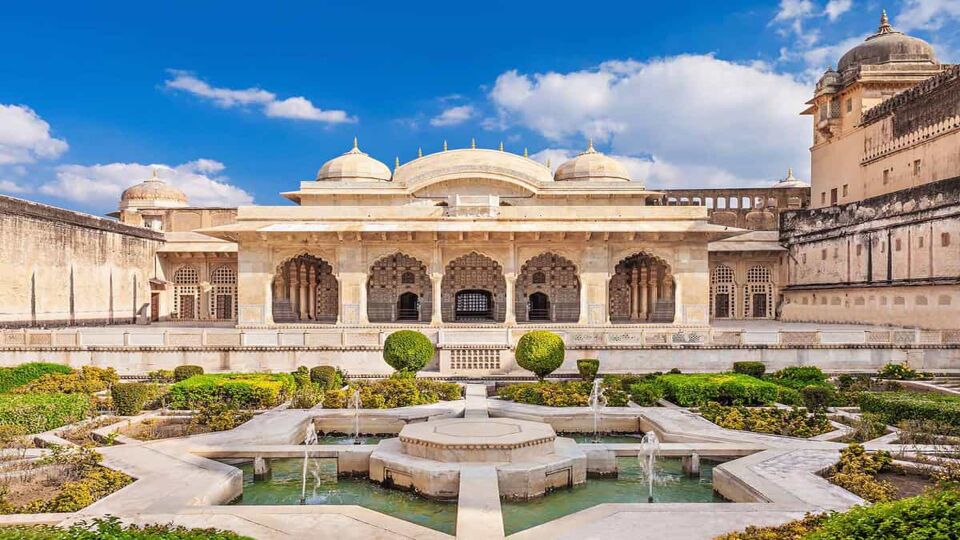Jaipur
Price $32
Min age 5
Rating 4.98 / 5 [1008 ratings]
Tour supplied by:
Bucket list destination:
Agra, Rajasthan, India

Rajasthan – the ‘land of princes’ and more colloquially called the ‘Desert State’ – was the Rajput heartland, a warrior caste whose clans were led by maharajas who favoured and built impressive forts and opulent palaces. Jaipur – Rajasthan’s capital – was founded in the early 1700s by Maharaja Jai Singh II, for whom it is named after.
Modern-day Jaipur is a compelling blend of huge hillside forts, extravagant palaces, bustling bazaars, memorable heritage hotels and almost comically thronged streets. Often called the ‘Pink City’, as its historic core’s buildings and their arcaded facades are still painted in terracotta pink, it’s a great place to mix sightseeing and leisure. It also boasts some of India’s most eclectic handicrafts and interesting shopping.
Now a UNESCO World Heritage Site, this vibrant city ticks every cultural, architectural and shopping box. It’s also home to some magnificent hotels that beautifully screen the urban hubbub.
Although generally referred to as the ‘Pink City’ (after the predominant colour of its buildings), within Jaipur itself this epithet simply covers the original walled and gated capital erected by Maharaja Jai Singh in the 1720s. Its imposing cupola-topped gateways remain useful landmarks because today’s city stretches well beyond those walls.
Key sights such as the City Palace and Hawa Mahal lie in and around the original Pink City, its grid layout veined with smaller streets, lanes and alleys.
To its north alongside Man Sagar Lake rise rugged hills topped by the ramparts of Nahargarh Fort; further along this ridge but out of view from the city stand Jaigarh Fort and the landmark Amber Fort-Palace.
Our selection of the best Viator tours of this destination, plus helpful tickets and transfers
Jaipur
Price $32
Min age 5
Rating 4.98 / 5 [1008 ratings]
Tour supplied by:
Jaipur
Price $9
Min age 6
Rating 4.95 / 5 [354 ratings]
Tour supplied by:
Jaipur
Price $10
Min age 0
Rating 4.96 / 5 [289 ratings]
Tour supplied by:
Jaipur
Price $40
Min age 0
Rating 4.97 / 5 [264 ratings]
Tour supplied by:
Jaipur
Price $134
Min age 0
Rating 4.82 / 5 [215 ratings]
Tour supplied by:
The main ‘foreign tourist season’ runs from October to March – clear skies with warm to hot days. Peak season is Christmas and New Year as well as the Indian festival of Diwali in late autumn.
May and June bring extreme heat and are worth avoiding while the July and August monsoon cools things slightly but brings more humidity. Mid-December to early February can deliver surprisingly chilly nights.
Jaipur is served by a small range of international and many domestic flights including to/from Delhi (one hour). There are no direct or practical flights between Jaipur and Agra.
To get from its airport to the city centre (about 8 miles) there are public buses and taxis (taxis are best booked using the pre-paid taxi counter inside the terminal).
For travel to/from other cities, Jaipur is well-connected on India’s vast train and bus network. Delhi, Agra and Jaipur are all connected by numerous trains and public buses, but the best public transport option is the express ‘Shatabdi’ or superfast-designated train services between New Delhi railway station and Jaipur which are safe and reliable. Numerous other regular (ie non-Shatabdi) express trains link Jaipur and Agra.
Auto-rickshaws are the cheapest option to get from train and bus stations to your hotel though (unless you grab the slightly larger ones that also have rear-facing seats) not comfortable or practical if carrying more than a small backpack or suitcase.
Many visitors are likely to have a chauffeured car – easily the most comfortable and convenient option for getting around the city. Most upscale hotels can arrange this with little notice or, almost certainly cheaper, you can simply use local travel agencies.
Autorickshaws nip around everywhere in Jaipur – cheap and cheerful though some won’t enjoy the seemingly stunt-like death-defying road etiquette characterising Indian roads. The city’s metro is clean and efficient but not yet particularly comprehensive.
One of Jaipur’s main attractions is the breadth of high-end hotels, especially those in former royal palaces which have been tastefully if not opulently adapted to take guests. Less obvious are the almost-palatial havelis, or merchants’ mansions, also adapted for guests.
With a few exceptions these stand outside (but still reasonably close to) the core historic Pink City where there’s more space for tranquil private lawns and gardens offering a welcome respite from the city’s bustle.
Stretching across central Jaipur and on the southern edge of the old city, MI road has several good restaurants. Eateries and snack joints tend to dominate the old city. For ‘fine dining’ head to the upmarket hotels.
Famed for handicrafts in general, Jaipur really excels in textiles and gems/jewellery. The central Pink City bazaars and markets abound in both but Johri (or Johari) bazaar is the apex of Jaipur’s jewellery trade.
Midway between Sanganeri Gate and the Hawa Mahal, the old city’s Bapu Bazaar is probably the single best place for shopping, especially decorative handicrafts, puppets, clothing and (camel) leather footwear, though you’ll need to sharpen your bargaining skills. Other places worth checking out are Nehru, Kishanpol and Tripolia bazaars.
A great fixed-price alternative is the state-run Rajasthali Handicraft Emporium (on MI Road opposite Ajmeri Gate) which focuses mainly on Rajasthani handicrafts.
The Narain Niwas Palace hotel near Central Park has a charming shopping courtyard with several well-known high-end boutiques.